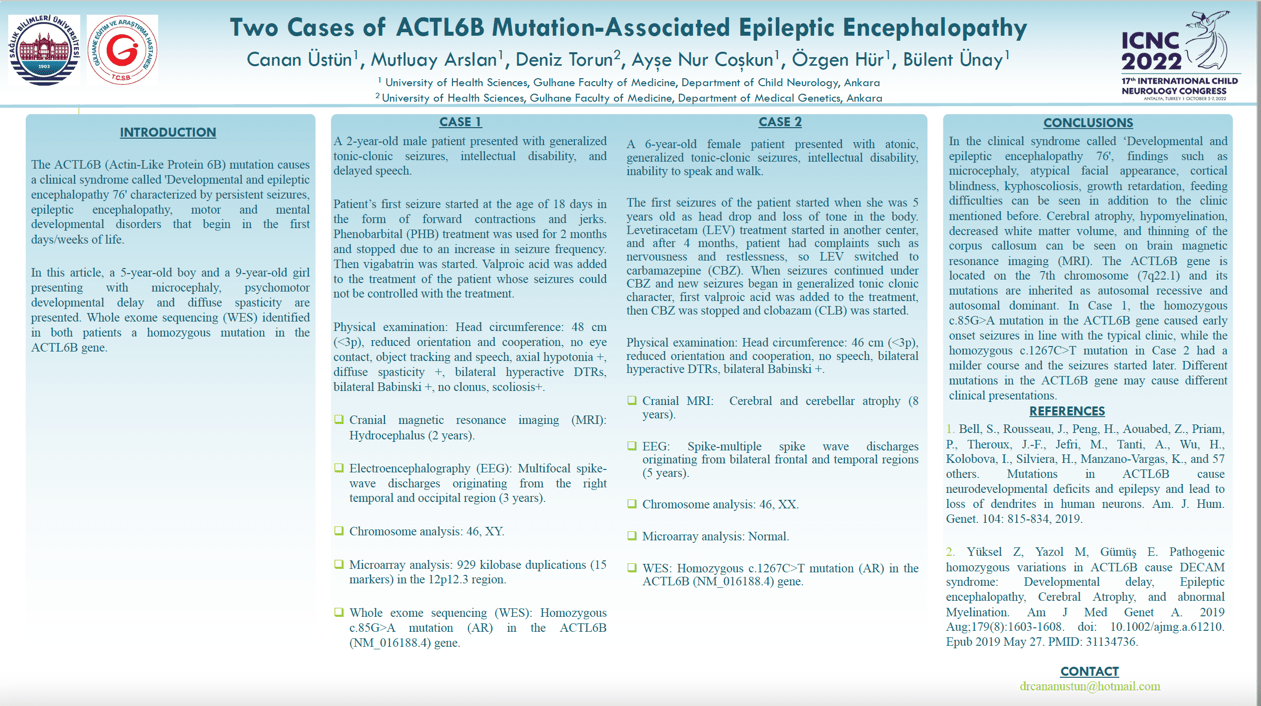Two Cases of ACTL6B Mutation-Associated Epileptic Encephalopathy
Canan Üstün, Mutluay Arslan, Deniz Torun, Ayşe Nur Coşkun, Özgen Hür, Bülent Ünay
ACTL6B (Actin-Like Protein 6B) mutation causes clinical syndrome called 'Developmental and Epileptic Encephalopathy 76', which is characterized by persistent seizures starting in the first days/weeks of life, epileptic encephalopathy, motor and mental developmental disorders, speech retardation, axial hypotonia, dystonia, spastic tetraplegia, and muscle atrophy. Some patients may have additional findings such as microcephaly, atypical facial appearance, cortical blindness, kyphoscoliosis, growth retardation, and feeding difficulties. Brain magnetic resonance imaging (MRI) may show cerebral atrophy, hypomyelination, decreased white matter volume and thinning of the corpus callosum. Multifocal epileptic activity, spike-wave discharges, and slowing of background rhythm can be seen in electroencephalography (EEG). The ACTL6B gene is located on chromosome 7 (7q22.1) and its mutations are inherited as autosomal recessive and autosomal dominant. Two patients are presented in this article due to ACTL6B mutation rarity; first one is a 5-year-old male patient with seizures begining at 18 days of age, microcephaly, psychomotor retardation, diffuse spasticity, scoliosis and an enlargement of the extraaxial CSF space in the anterior of both temporal lobes on brain MRI. Second one is a 9-year-old female patient with microcephaly, psychomotor developmental delay, diffuse spasticity, generalized tonic clonic seizures starting the age of 5 years, and cerebral, cerebellar atrophy on brain MRI. The definitive diagnosis of the patients was made by detecting the ACTL6B mutation in the Whole Exome Sequencing (WES) analysis.
Keywords: Developmental and epileptic encephalopathy76, Actin-Like Protein 6B, ACTL6B, epileptic encephalopathy
Canan Üstün
Gülhane Training and Research Hospital of the University of Health Sciences
Turkey
Mutluay Arslan
Gülhane Training and Research Hospital of the University of Health Sciences
Turkey
Deniz Torun
Gülhane Training and Research Hospital of the University of Health Sciences
Turkey
Ayşe Nur Coşkun
Gülhane Training and Research Hospital of the University of Health Sciences
Turkey
Özgen Hür
Gülhane Training and Research Hospital of the University of Health Sciences
Turkey
Bülent Ünay
Gülhane Training and Research Hospital of the University of Health Sciences
Turkey
ACTL6B (Actin-Like Protein 6B) mutation causes clinical syndrome called 'Developmental and Epileptic Encephalopathy 76', which is characterized by persistent seizures starting in the first days/weeks of life, epileptic encephalopathy, motor and mental developmental disorders, speech retardation, axial hypotonia, dystonia, spastic tetraplegia, and muscle atrophy. Some patients may have additional findings such as microcephaly, atypical facial appearance, cortical blindness, kyphoscoliosis, growth retardation, and feeding difficulties. Brain magnetic resonance imaging (MRI) may show cerebral atrophy, hypomyelination, decreased white matter volume and thinning of the corpus callosum. Multifocal epileptic activity, spike-wave discharges, and slowing of background rhythm can be seen in electroencephalography (EEG). The ACTL6B gene is located on chromosome 7 (7q22.1) and its mutations are inherited as autosomal recessive and autosomal dominant. Two patients are presented in this article due to ACTL6B mutation rarity; first one is a 5-year-old male patient with seizures begining at 18 days of age, microcephaly, psychomotor retardation, diffuse spasticity, scoliosis and an enlargement of the extraaxial CSF space in the anterior of both temporal lobes on brain MRI. Second one is a 9-year-old female patient with microcephaly, psychomotor developmental delay, diffuse spasticity, generalized tonic clonic seizures starting the age of 5 years, and cerebral, cerebellar atrophy on brain MRI. The definitive diagnosis of the patients was made by detecting the ACTL6B mutation in the Whole Exome Sequencing (WES) analysis.
Keywords: Developmental and epileptic encephalopathy76, Actin-Like Protein 6B, ACTL6B, epileptic encephalopathy
Canan Üstün
Gülhane Training and Research Hospital of the University of Health Sciences
Turkey
Mutluay Arslan
Gülhane Training and Research Hospital of the University of Health Sciences
Turkey
Deniz Torun
Gülhane Training and Research Hospital of the University of Health Sciences
Turkey
Ayşe Nur Coşkun
Gülhane Training and Research Hospital of the University of Health Sciences
Turkey
Özgen Hür
Gülhane Training and Research Hospital of the University of Health Sciences
Turkey
Bülent Ünay
Gülhane Training and Research Hospital of the University of Health Sciences
Turkey

Canan Üstün
Gülhane Training and Research Hospital of the University of Health Sciences , Turkey
Gülhane Training and Research Hospital of the University of Health Sciences , Turkey